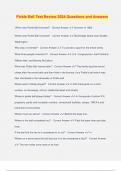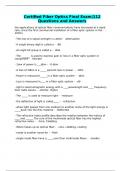Pathology Practice Test 3 Questions &
Answers 2024/2025
A 36-year-old woman has had increased malaise for 3 weeks and urine output <500 mL/day for the past
4 days. On examination, she has blood pressure 170/112 mm Hg and peripheral edema. Urinalysis shows
protein 1+ and blood 3+, but no glucose or ketones. Urine microscopic analysis shows RBCs and RBC
casts. Her serum urea nitrogen is 39 mg/dL, and creatinine is 4.3 mg/dL. Her serum complement C1q,
C3, and C4 are decreased. A renal biopsy is performed, and immunofluorescence microscopy shows a
granular pattern of staining with antibody to C3. Which of the following types of hypersensitivity
reactions is most likely causing her renal disease?
A I (IgE-mediated systemic anaphylaxis)
B II (Antibody-dependent cell-mediated cytotoxicity)
C III (Immune complex formation)
D IV (Delayed-type hypersensitivity) - ANSWERSC - The findings fit with immune-mediated glomerular
injury with antigen-antibody complex deposition, typical of an underlying disease such as SLE, and
nephritic picture. Type I hypersensitivity may play a role in drug-induced acute interstitial nephritis. Type
II hypersensitivity is present with anti-glomerular basement membrane diseases, such as Goodpasture
syndrome. Type IV hypersensitivity plays a role in renal transplant rejection and some cases of drug-
induced interstitial nephritis.
A 29-year-old man with chronic hepatitis C virus infection has noted dark urine for the past 2 weeks. On
examination he is hypertensive but afebrile. Laboratory studies show serum creatinine of 3.8 mg/dL and
urea nitrogen of 35 mg/dL. Cryoglobulins are detected. Urinalysis shows RBCs and RBC casts. A renal
biopsy is performed and microscopically shows hypercellular glomeruli with lobulation and a double-
contour appearance to split basement membranes adjacent to subendothelial immune complexes.
Which of the following cell types has most likely proliferated in his glomeruli?
A Juxtaglomerular cells
B Mesangial cells
C Parietal epithelial cells
D Podocytes
E Endothelial cells - ANSWERSB - The appearance of membranoproliferative glomerulonephritis, a cause
for nephritic syndrome in adults, is described. Mesangial cells have a phagocytic function, but they also
can elaborate inflammatory mediators, cytokines, and matrix. Proliferation of mesangial cells may be
induced by injury, particularly immune complex deposition. Juxtaglomerular cells secrete renin. Parietal
,epithelial cells line the Bowman capsule and may proliferate with severe glomerular injury to produce
crescents. Podocytes are visceral epithelial cells that form the filtration barrier. Endothelial cells are most
likely to be damaged with thrombotic microangiopathies.
A study of renal disease identifies patients with greater than 3.5 g of protein in a 24-hour urine
collection, but no RBCs or WBCs. Dysfunction involving which of the following cells is most likely to be
responsible for proteinuria?
A Endothelium
B Macula densa
C Mesangium
D Parietal epithelium
E Podocytes - ANSWERSE - The podocytes (visceral epithelial cells) of the glomerulus form a filtration
barrier that depends upon both the anionic charge as well as slit diaphragms. Injuries that cause
effacement, retraction, detachment, and vacuolization allow protein, principally albumin, to escape into
Bowman space. Podocytes have limited capacity for regeneration and repair. The loss of 3.5 g/day of
protein defines nephrotic syndrome. About a sixth of filtration occurs through the mesangium. The
remaining listed options do not participate in this epithelial protein filtration barrier.
A 7-year-old boy is recovering from impetigo. Physical examination shows five honey-colored crusts on
his face. The crusts are removed, and a culture of the lesions grows Streptococcus pyogenes. He is
treated with antibiotics. One week later, he develops malaise with nausea and a slight fever and passes
dark brown urine. Laboratory studies show a serum anti-streptolysin O titer of 1:1024. Which of the
following is the most likely outcome of his renal disease?
A Chronic renal failure
B Complete recovery
C Crescentic glomerulonephritis
D Rheumatic heart disease
E Streptococcal urinary tract infection - ANSWERSB - The strains of group A streptococci that cause
poststreptococcal glomerulonephritis (GN) differ from the strains that cause rheumatic fever, and most
elicit an immune response via streptococcal pyogenic exotoxin B (SpeB). Most children with
poststreptococcal GN recover, although 1% develop a rapidly progressive GN characterized by crescent
formation. Progression to chronic renal failure occurs in 40% of affected adults. A urinary tract infection
is not likely to accompany poststreptococcal GN because the organisms that caused the immunologic
reaction are no longer present when symptoms of GN appear.
,A 45-year-old man has experienced increasing malaise, nausea, and reduced urine output for the past 3
days. On physical examination, he is afebrile and normotensive. Laboratory findings show a serum
creatinine level of 7.5 mg/dL. Urinalysis shows hematuria, but no pyuria or glucosuria. A renal biopsy is
done; the light microscopic picture is shown in the figure. Which of the following additional studies is
most useful for classification and treatment of this disease?
A Antinuclear antibody
B Anti-glomerular basement membrane antibody
C HIV-1 RNA copy level
D Quantitative serum immunoglobulins
E Rheumatoid factor
F Urine immunoelectrophoresis - ANSWERSB - The figure shows glomeruli with epithelial crescents
indicative of a rapidly progressive glomerulonephritis. Crescentic GN is divided into three groups on the
basis of immunofluorescence: type I (anti-glomerular basement membrane [GBM] disease); type II
(immune complex disease); and type III (characterized by the absence of anti-GBM antibodies or
immune complexes). Each type has a different cause and treatment. The presence of anti-GBM
antibodies suggests Goodpasture syndrome; patients with this disorder require plasmapheresis. Type II
crescentic GN can occur in systemic lupus erythematosus, in Henoch-Schönlein purpura, and after
infections. Causes of type III crescentic GN include granulomatosis with polyangiits (ANCA-associated
vasculitis) and microscopic polyangiitis. A positive ANA test result may be reported in patients with lupus
nephritis, which uncommonly manifests with glomerular crescents. HIV nephropathy has features similar
to those of focal segmental glomerulosclerosis (FSGS), which is not rapidly progressive. Quantitative
serum immunoglobulins are not helpful because the important consideration is the pattern of immune
deposits in the kidney. Rheumatoid factor is present in rheumatoid arthritis, which is not typically
associated with renal complications. Urine immunoelectrophoresis is useful in categorizing a monoclonal
gammopathy.
A 21-year-old previously healthy man has noticed blood in his urine for the past 2 days. He reports no
dysuria, frequency, or hesitancy of urination. On physical examination, there are no abnormal findings.
Laboratory findings show a serum urea nitrogen level of 39 mg/dL and creatinine level of 4.1 mg/dL. A
renal biopsy specimen is obtained; the immunofluorescence pattern of staining with antibody against
human IgG is shown in the figure. Which of the following serologic findings is most likely to be present in
this patient?
A Anti-glomerular basement membrane antibody
B Anti-streptolysin O antibody
C C3 nephritic factor
D Hepatitis B surface antibody
, E HIV antibody - ANSWERSA - The linear pattern of staining shown in the figure indicates the presence of
anti-glomerular basement membrane antibodies (directed against the noncollagenous domain of the α3
chain of type IV collagen). Such antibodies are typically seen in Goodpasture syndrome, a form of rapidly
progressive glomerulonephritis (GN) that has a bimodal pattern of occurrence in younger and older men.
The anti-streptolysin O titer is increased in poststreptococcal GN, which typically has a granular pattern
of immune complex deposition. The C3 nephritic factor can be a marker for dense deposit disease. Some
cases of membranous nephropathy are associated with hepatitis B virus infection, but the immune
complex deposition is granular, not linear. HIV infection can lead to a nephropathy that resembles FSGS,
in which IgM and C3 are deposited in the mesangial areas of affected glomeruli.
A 48-year-old man has had increased swelling in the extremities for 2 months. Physical examination
showed generalized edema. A 24-hour urine collection yielded 4.1 g of protein (albumin and globulins).
He did not respond to a course of corticosteroid therapy. A renal biopsy was done, and microscopic
examination showed diffuse thickening of the basement membrane. Immunofluorescence staining with
antibody to the C3 component of complement was positive in a granular pattern in the glomerular
capillary loops. Two years later, he experiences increasing malaise. Laboratory studies now show serum
creatinine level of 4.5 mg/dL and urea nitrogen level of 44 mg/dL. Which of the following immunologic
mechanisms was most likely responsible for the glomerular changes observed in the biopsy specimen?
A Antibodies that react with basement membrane collagen
B Antibodies against streptococci that cross-react with the basement membran - ANSWERSD - Nephrotic
syndrome may be produced by an idiopathic form of membranous nephropathy. Diffuse basement
membrane thickening, in the absence of proliferative changes, and granular deposits of IgG and C3 are
typical of this condition. It is caused by antibody targeting M-type phospholipase A 2 receptor antigen,
the deposition of immune complexes on the basement membrane, and complement activation. In 75%
of patients with membranous nephropathy, the cause of immune complex deposition is unknown. In the
remaining cases an associated systemic disease (e.g., systemic lupus erythematosus) or some known
cause of immune complex formation (e.g., drug reaction) exists. Antibodies that react with basement
membrane give rise to a linear immunofluorescence pattern, as in Goodpasture syndrome. Membranous
nephropathy has no association with streptococcal infections. There also is no evidence of cytokine-
mediated or T cell-mediated damage in this disease.
A 7-year-old boy has become less active over the past 10 days. On physical examination, the boy has
facial puffiness. Urinalysis shows no blood, glucose, or ketones, and microscopic examination shows no
casts or crystals. The serum creatinine level is normal. A 24-hour urine collection yields 3.8 g of protein.
He improves after corticosteroid therapy. He has two more episodes of proteinuria over the next 4 years,
both of which respond to corticosteroid therapy. What is the most likely mechanism causing his disease?
A Cytokine-mediated visceral epithelial cell injury
B Cytotoxic T cell-mediated tubular epithelial cell injury
C IgA-mediated mesangial cell injury






